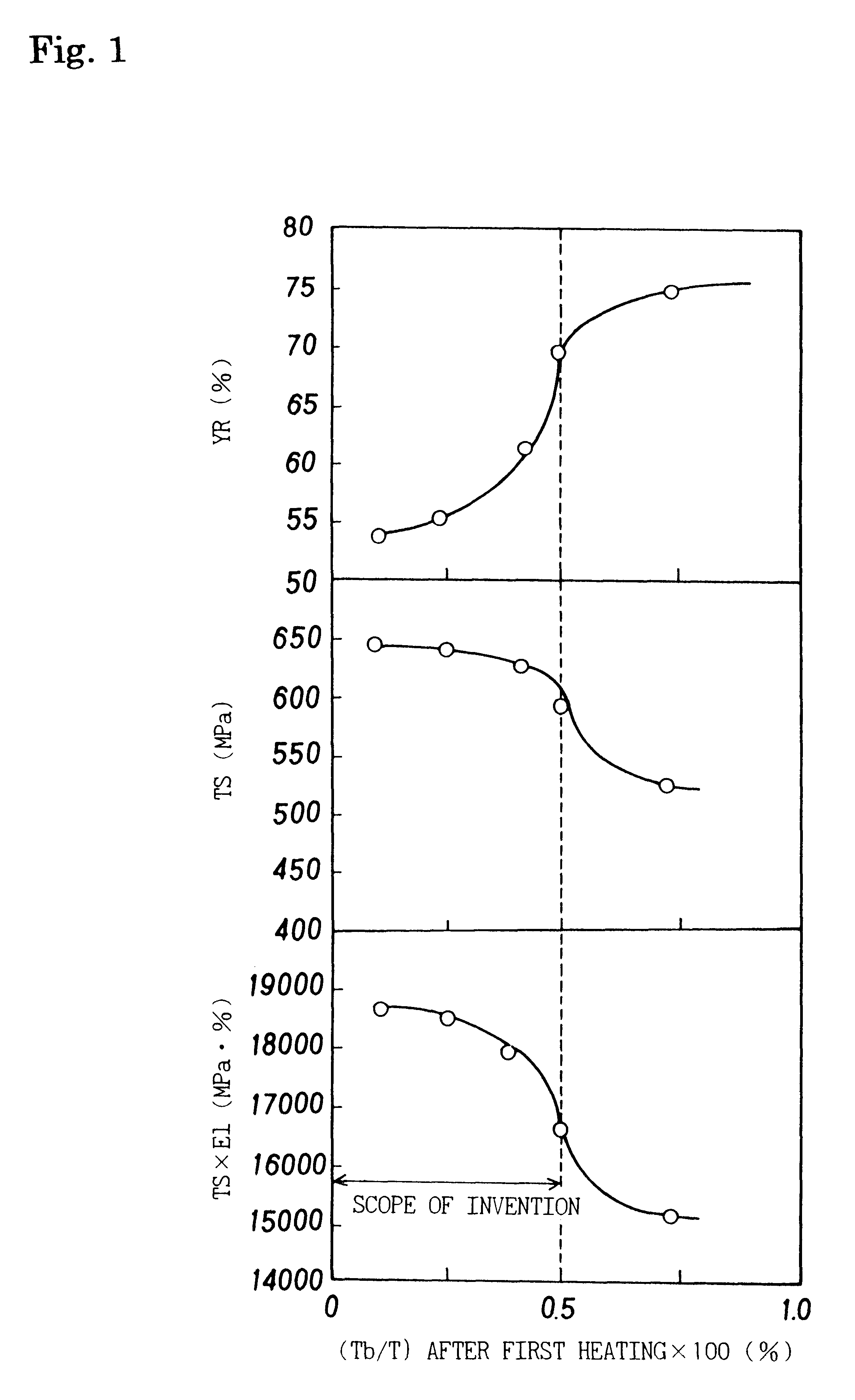High strength thin steel sheet, high strength alloyed hot-dip zinc-coated steel sheet, and method for producing them
a technology of high strength, high strength, and high strength, applied in the direction of furnaces, heat treatment equipment, applications, etc., can solve the problems of difficult to obtain a high tensile strength, serious deterioration of galvanizing properties, and higher cost, so as to improve galvanizing properties and threadability.
- Summary
- Abstract
- Description
- Claims
- Application Information
AI Technical Summary
Benefits of technology
Problems solved by technology
Method used
Image
Examples
example 1
(Examples 1-20, comparative Examples 1-12)
[Dispersion of Band Structures in Steel Sheet]
A continuously cast slab having a chemical composition (kinds of steel A to Q) shown in Table 1 and a thickness of 300 mm was heated to 1,200.degree. C., roughly rolled through two passes, and then coiled in the form of a hot-rolled steel sheet having a thickness of 2.3 mm on a 7-stand finishing mill.
After pickling, the hot-rolled steel sheet thus obtained was heated directly for Experiments Nos. 1, 9, 11, 12, 17, 19, 20, 27, 28 and 29, and heated after cold rolling to a thickness of 1.0 mm for Experiments Nos. 2-8, 10, 13-16, 18, 21-26 and 30-32, on a continuous annealing line (first run of heating). On a continuous hot-dip galvanizing line, the steel sheet was pickled, heated (first or second run of heating) and the galvanized, and as required subjected further to a galvannealing treatment.
For some of the kinds of steel C to E, the 1.0 mm-thick cold-rolled steel sheet was heated on the continuo...
example 2
(Examples 21-37, Comparative Examples 13-21)
[Two-stage Heating-pickling]
A 300 mm-thick continuously cast slab having a chemical composition shown in Table 1 (kinds of steel: A-D, DD, F-I, K-N, R-X) was heated to 1,200.degree. C., roughly rolled through three passes, and rolled on a 7-stand finishing mill into a hot-rolled steel sheet having a thickness of 2.3 mm.
The hot-rolled steel sheet was then coiled at a temperature (CM) shown in Tables 4 and 5.
After pickling, the resultant steel sheet was passed through a continuous annealing line in an as-hot-rolled state for Experiments Nos. 33, 43-49, and 52-54, and for Experiments Nos. 34-42, 50, 61 and 55-58, the sheet was cold-rolled into a thickness of 1.0 mm, then threaded into the continuous annealing line, and annealed at a heating temperature shown in Tables 4 and 5.
Subsequently, the rolled steel sheets of various kinds of steel thus obtained were sent to a continuous hot-dip galvanizing line, and subjected to pickling, heating-redu...
example 3
(Examples 38-46, Comparative Example 22)
[Single-heating Treatment]
Various cold-rolled steel sheets of different kinds of steel were passed through the continuous hot-dip galvanizing line and subjected to heating-reduction, hot-dip galvanizing, and galvannealing treatment in the same manner as in the aforementioned Examples 21 to 23 and 25 to 37 except that annealing before passing to the continuous hot-dip galvanizing line and pickling on the continuous hot-dip galvanizing line were omitted, and the resultant hot-dip galvanized steel sheets (not-yet-galvannealed hot-dip galvanized steel sheets) and galvannealed steel sheets were subjected to evaluation in the same manner as in Examples 21 to 23 and 25 to 37.
The manufacturing conditions are shown in Table 8, and the result obtained, in Table 9.
The coating weight of the galvannealing layer was within a range of from 30 to 60 g / m.sup.2 for both sides of the steel sheet in all cases.
As shown in Tables 8 and 9, it is now possible to prev...
PUM
| Property | Measurement | Unit |
|---|---|---|
| Time | aaaaa | aaaaa |
| Angle | aaaaa | aaaaa |
| Angle | aaaaa | aaaaa |
Abstract
Description
Claims
Application Information
 Login to View More
Login to View More - R&D
- Intellectual Property
- Life Sciences
- Materials
- Tech Scout
- Unparalleled Data Quality
- Higher Quality Content
- 60% Fewer Hallucinations
Browse by: Latest US Patents, China's latest patents, Technical Efficacy Thesaurus, Application Domain, Technology Topic, Popular Technical Reports.
© 2025 PatSnap. All rights reserved.Legal|Privacy policy|Modern Slavery Act Transparency Statement|Sitemap|About US| Contact US: help@patsnap.com



